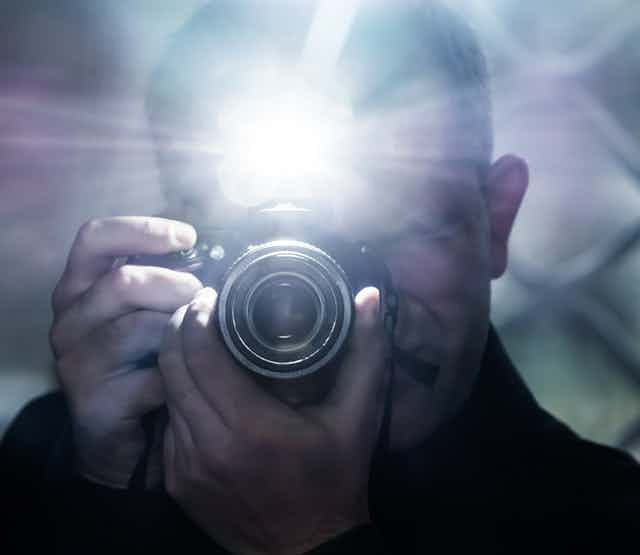Queensland federal MP Andrew Laming has been accused of taking an inappropriate photograph of a young woman, Crystal White, in 2019 in which her underwear was showing. When challenged about the photo this week, he reportedly replied:
it wasn’t meant to be rude. I thought it was funny
Inappropriate photography is a criminal offence in Queensland. Whether or not Laming’s behaviour amounted to an offence for which he could be charged is a matter for the police to determine. (White is reportedly considering taking her complaint to police.)
So, what do the laws say about this kind of behaviour, and what rights to privacy do people have when it comes to indecent photographs taken by others?

What can ‘upskirting’ include?
A new term has entered the lexicon in this regard: “upskirting”. The act of upskirting is generally defined as taking a sexually intrusive photograph of someone without their permission.
It is not a recent phenomenon. There have been incidents in which people (invariably men) have placed cameras on their shoes and photographed “up” a woman’s skirt for prurient purposes. Other instances have involved placing cameras under stairs where women in dresses or skirts were likely to pass by.
The broader category of “upskirting” can also include indecent filming of anyone without their knowledge, including photographing topless female bathers at a public beach, covertly filming women undressing in their bedrooms, or installing a camera in a dressing room, public toilet or a swimming pool changing room.
Read more: Andrew Laming: why empathy training is unlikely to work
With every new electronic device that comes on the market comes the possibility of inappropriate use and, thus, the creation of new criminal offences.
We saw that with the advent of small listening devices. With this technology, it was now possible to record private conversations, so legislators had to create offences under the law to deal with any inappropriate use.
The same thing happened with small (and now very affordable) drones, which made it possible to capture images of people in compromising positions, even from a distance. Our laws have been adjusted accordingly.
And in recent years, lawmakers have been faced with the same potential for inappropriate use with mobile phones. Such devices are now ubiquitous and improved technology has allowed people to record and photograph others at a moment’s notice — often impulsively, without proper thought.
How have legislators responded in Australia?
There is a patchwork array of laws across the country dealing with this type of photography and video recording.
In South Australia, for instance, it is against the law to engage in “indecent filming” of another person under part 5A of the state’s Summary Offences Act.
The term “upskirting” itself was used when amendments were made in 2007 to Victoria’s Summary Offences Act. This made it an offence for a person to observe or visually capture another person’s genital region without their consent.
In New South Wales, the law is equally specific in setting out the type of filming that is punishable under the law. It outlaws the filming of another person’s “private parts” for “sexual arousal or sexual gratification” without the consent of the person being filmed.
Queensland’s law, meanwhile, makes it an offence to:
observe or visually record another person, in circumstances where a reasonable adult would expect to be afforded privacy […] without the other person’s consent
Interestingly, the Queensland law is more broadly worded than the NSW, Victorian or South Australian laws since it makes it an offence to take someone’s picture in general, rather than specifying that it needs to be sexually explicit.
The maximum penalty for such an offence in Queensland is three years’ imprisonment.
What would need to be proven for a conviction
Just like any criminal offence, the prosecution in a case like this must first determine, before laying a charge, whether there’s enough evidence that could lead to a conviction and, moreover, whether such a prosecution is in the public interest.
Once the decision to charge is made, a conviction will only be possible if the accused pleads guilty or is found guilty beyond reasonable doubt. (Being a misdemeanour, this could only be by a magistrate, not a jury.)
The role of the criminal law here is to bring offending behaviour to account while also providing a deterrent for the future conduct of that person or any other persons contemplating such an act.
As with any criminal law, its overarching purpose is to indicate society’s disdain for the behaviour. The need to protect victims from such egregious and lewd behaviour is an important consideration too.
Any decision by a Queensland magistrate to convict a person alleged to have taken an indecent photo would hang on three facts:
whether the photo was taken by the person accused
whether the victim believed she should have been afforded privacy
and whether she offered no consent to have the photo taken.
Other mitigating factors might come into play, however, including whether the photograph was impulsive and not premeditated, whether the image was immediately deleted, and whether the alleged offender showed any regret or remorse for his actions.
Recently a Queensland man, Justin McGufficke, pleaded guilty to upskirting offences in NSW after he took pictures up the skirts of teenage girls at a zoo while they were looking at animals.
In another case, a conviction for upskirting was deemed sufficient to deny a man permission to work with children in Victoria.
In a moment of impulsivity — and with the easy access of the mobile phone — anything can happen in today’s world. Poor judgements are common. Women are invariably the targets.
The laws on filming, recording and in some cases distributing the images of another person are clear — and the potential consequences for the accused are substantial. One would hope that any potential offenders are taking note.

